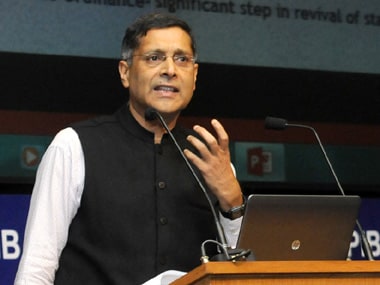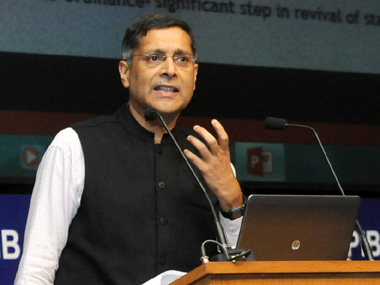Chief Economic Advisor (CEA) Arvind Subramanian’s recommendations on the Goods and Services Tax (GST) Bill offer the much-needed, more-feasible economic solutions to resolve the long-standing political deadlock between the BJP and the Congress on GST and get it passed in Parliament’s Winter Session itself.[caption id=“attachment_2399194” align=“alignleft” width=“380”]  Chief economic advisor Arvind Subramanian. Image courtesy PIB[/caption] Without doubt, this is a golden opportunity for the Narendra Modi government to tackle the Congress on the GST issue without losing its face in the political bargaining, and finally solve the GST conundrum. Why Modi should be excited about the CEA-panel recommendations? One, it perfectly aligns with two critical demands of the Congress party — 18 percent standard GST rate and scrapping of 1 percent inter-state trade tax. These two factors are already largely accepted stance on GST by industry, investor community and experts as an ideal GST structure to begin with. If the government accepts these proposals, it would be seen as a positive move. Two, if the government indeed accepts the CEA’s proposals and get the Congress on board to pass the Bill, it would be seen as a good gesture. It would mean the government is accepting the expert recommendations in the larger interest of the country and not surrendering to the opposition’s demands in a political fight. The CEA panel has suggested a three-rate structure. A concessional rate of 12 percent for public goods that concerns the deprived or weaker sections, a standard rate of 17-18 percent that would concern majority of items and a rate of 40 percent for luxury items and tobacco, aerated drinks and pan masala etc. Modi shouldn’t miss this chance to get the opposition on board and get the GST done in Parliament as quickly as possible. Clearly without the Congress support, the BJP wouldn’t be in a position to get the Bill through in Rajya Sabha, where it is weak in terms of numbers. An 18 percent standard GST would be ideal to start with since a rate too high would hurt service/ consumer states and too low would do the same to producer states. But the government has to convince the opposition to let the GST council decide the future unified rate and not include in the Bill. This is because if the rate (say 18 percent) is included in the Bill, in case of revenue loss in future, the government would find it difficult to adjust the rate. It needs to go through parliament and state assemblies. Except this, the rest of the points of concerns, such as the willingness of state governments to accept the GST structure and the ways to compensate the states in the initial years aren’t insoluble issues. If the government accepts the CEA proposals, a GST structure with a 17-18 percent standard rate and the provision to move essential items to the lower band and a medium-term objective to arrive at a single rate, doesn’t look too bad to begin with. Time running out It is highly crucial for the Modi government not to miss the April 1 deadline for GST rollout. That means the Bill has to be passed in the current session itself. This is essential to convince international investors about the ability and intent of the Modi administration to fulfil its promises of large reforms in the economy post Bihar. Beyond FDI liberalisation in a few sectors and some minor incremental reforms, Modi hasn’t managed yet to introduce any big-ticket reforms yet. GST is important for the economy to emerge even stronger. A simplified, single tax regime will improve compliance and can significantly improve the revenue collections over a period of time, subsuming several stand alone taxes. This will add to at least 1-1.5 percent to the GDP going by estimates. Besides, the GST is the only key reform that can happen at the current stage. The Land Acquisition Bill, another key reform, is off the table for some time as it has been diluted and also as the interested state governments are finding a way out of the mess. Thus, state governments, including the Congress-ruled states, can never pass the blame to the Centre as far as land acquisition is concerned. There is no better time to push the Congress to consent on the GST since Modi has taken the first and important step in building consensus by initiating discussions with top opposition leaders. The Congress wouldn’t do the blunder of eternally opposing the GST since it is very well recognised that its passage is important for the economy and can very well backfire if it continues to oppose the Bill even after the BJP agrees to its major demands. Already, the BSP, JD(U) and the TMC have extended their support to the GST Bill. The BSP has 10 members in Rajya Sabha, JD (U) has 12 members and TMC has 12 members. If the BJP can get the Congress too on board, it isn’t too difficult to get the Bill passed. The likely Congress strategy would be to delay the GST passage to the extent possible, before it finally agrees, to maintain its bargaining edge over the BJP. The bottomline is this: The Subramanian panel has brightened the chances of a consensus on the GST issue in the Winter Session and it is up to Modi to use this opportunity.
The Subramanian panel has brightened the chances of a consensus on the GST issue in the Winter Session and it is up to Modi to use this opportunity
Advertisement
End of Article


)
)
)
)
)
)
)
)
)



